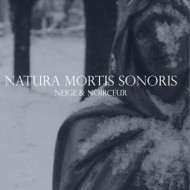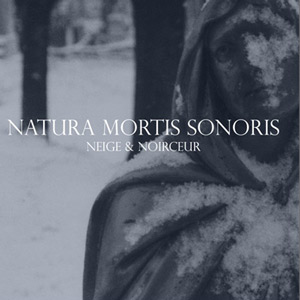 I’m sure I can’t be alone in listening to an album I haven’t heard for some time and wondering why on earth I hadn’t played it more. Such is the case with “Seigneries des Loups” (2010) by this French-Canadian black metal band. Madcap and with lively folk twists, it’s as engaging as it gets. By contrast I never got the follow-up “Hymes de la Montagne Noire”, which didn’t have the same eccentricity and was for me a bit of hit-and-miss.
I’m sure I can’t be alone in listening to an album I haven’t heard for some time and wondering why on earth I hadn’t played it more. Such is the case with “Seigneries des Loups” (2010) by this French-Canadian black metal band. Madcap and with lively folk twists, it’s as engaging as it gets. By contrast I never got the follow-up “Hymes de la Montagne Noire”, which didn’t have the same eccentricity and was for me a bit of hit-and-miss.
But “Natura Mortis Sonoris” is different. First of all it’s a compilation ranging from a collection of eps, demos and albums going back to 2005. It is nothing like I expected. Imagination and even humour were in evidence on “La Seigneurie des Loups” but now this is a series of ambient tracks, droning, rustling noises, church bells, deep electronic soundwaves and a creation which sits between the tranquillity of nature and the horrors of war. It’s a “proper” album. Although it comes from a variety of sources, it’s done mindlessly in chronological order but with the intention of co-ordinating this electronically dark ambiance. The tracks, which smack of Troum and Burzum, are versions to suit the theme.
After the sound of closing doors, heavy breathing and mantra-like moaning, we arrive at the human wind tunnel of “Sommeil Profond” (Deep Sleep). After the breathing there’s the sound of crows. The ambiance of “Après la Nuit l’Ecume des Nuits” (After the Night, the Scum of Nights) is such that it sounds like another world, or maybe a forest where mysterious sound waves reflect through trees and darkness. Constant electronic sounds mix with the whistling tunnel winds. An indistinguishable croaking can be heard in the distance. It is scary. It is chilling.
Deep and melancholic sounds continue but with quiet acoustics. “Hibernation” was first aired on the 2009 album “Crépuscule Hivernale sans fin sur les Terres de la Guerre” (Endless Winter Twilight on the Fields of War). The fields of war will no doubt be Quebec, native territory of Neige et Noirceur’s creator Spiritus, and scene of the seven year war between the British and the French from 1759. Yet it is quiet and strangely relaxing but not comforting. Obscure shifting movements can be heard in the background. Is that an explosion or a heartbeat? The sound expands like an echo across a void. This is “Loudun part II”, a scene of alleged witchcraft in the early 17th century. The sound is orchestral … majestic … strange. The seemingly eternal calm is disturbed by another explosion. We’re not at a standstill but it’s a tranquil world. A spoken voice can be heard. The atmosphere then changes. The whistling intensifies. A cold, cold wind sweeps through the scene. Harsh weather is another feature of Quebec and it seems that winter is setting in. There’s an electronic drone in the background. This is a snowy scene. It’s bleak and desolate out there. The blizzard spreads amid the dark ambiance. We hear mechanical sounds. But it’s all obscure. Now there’s an eerie calm, but it’s always under the threat of disturbance. We feel heightened tensions and hear muffled voices. “Descente” builds up and the winds get up too. There’s a threat of violence in the air. For the first time we experience black metal but it’s fleeting. We, the listeners, are placed in inhospitable surroundings as the winds continue to howl.
It is now 18th August 1634. A judge condemns a prisoner to execution by burning at the stake for obscenity, blasphemy and sacrilege. It must be Urban Grandier, the Catholic priest who was found guilty of witchcraft. A plaque will be erected, the judge announces. The scene is truly horrible. The electronic drone then returns as if we are in a void between two bad places. A narrator now speaks clearly and precisely in French and utters his terrible words: “deux specimens humains seront immolés ce soir” (two human specimens will be sacrificed this evening). The crowd reels in shock and horror. The drone continues and throbs on dispassionately. The Burzum – Troum ambiance always there but now with the faint sounds of battle in the distance. “Loin des Hommes, Prêt des Bêtes” (Far from Men, Near to Animals) takes us in another direction. Crows are in the woods. Slow and steady musical progress is being made. We have no control over this. It drones on relentlessly. Sounds appear from nowhere and disappear like passing shapes. Cold winds emerge again. It’s like a hymn but now the coldness and bleakness are starting to take over, only punctuated by the obscure sounds of gunfire and dripping water. It’s very distorted. The feel is of permanent winter and it is cold. Then “Cimitière Amérindien” (American-IndianCemetery) becomes distinctly funereal. The winds meanwhile rush through and accompany the quiet electronic drone. No people can be sensed in this desolate scene. There is just gloom and sorrow of magnificent proportions.
Sounds move in and move out. It seems there are moments of stillness and non-activity, yet there are subtle sounds everywhere, many of which cannot be defined. Nature, winter, war and death combine on this mesmerising. “Natura Mortis Sonoris” is an eerie and discomforting experience. This is the world of ambient inhospitality and ghastliness.
(8.5/10 Andrew Doherty)
http://www.zimondofin.com/neigeetnoirceur

Leave a Reply